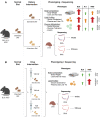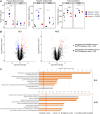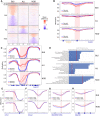Precision pharmacological reversal of strain-specific diet-induced metabolic syndrome in mice informed by epigenetic and transcriptional regulation
- PMID: 37871105
- PMCID: PMC10621921
- DOI: 10.1371/journal.pgen.1010997
Precision pharmacological reversal of strain-specific diet-induced metabolic syndrome in mice informed by epigenetic and transcriptional regulation
Abstract
Diet-related metabolic syndrome is the largest contributor to adverse health in the United States. However, the study of gene-environment interactions and their epigenomic and transcriptomic integration is complicated by the lack of environmental and genetic control in humans that is possible in mouse models. Here we exposed three mouse strains, C57BL/6J (BL6), A/J, and NOD/ShiLtJ (NOD), to a high-fat, high-carbohydrate diet, leading to varying degrees of metabolic syndrome. We then performed transcriptomic and genome-wide DNA methylation analyses for each strain and found overlapping but also highly divergent changes in gene expression and methylation upstream of the discordant metabolic phenotypes. Strain-specific pathway analysis of dietary effects revealed a dysregulation of cholesterol biosynthesis common to all three strains but distinct regulatory networks driving this dysregulation. This suggests a strategy for strain-specific targeted pharmacologic intervention of these upstream regulators informed by epigenetic and transcriptional regulation. As a pilot study, we administered the drug GW4064 to target one of these genotype-dependent networks, the farnesoid X receptor pathway, and found that GW4064 exerts strain-specific protection against dietary effects in BL6, as predicted by our transcriptomic analysis. Furthermore, GW4064 treatment induced inflammatory-related gene expression changes in NOD, indicating a strain-specific effect in its associated toxicities as well as its therapeutic efficacy. This pilot study demonstrates the potential efficacy of precision therapeutics for genotype-informed dietary metabolic intervention and a mouse platform for guiding this approach.
Copyright: © 2023 Wulfridge et al. This is an open access article distributed under the terms of the Creative Commons Attribution License, which permits unrestricted use, distribution, and reproduction in any medium, provided the original author and source are credited.
Conflict of interest statement
The authors have declared that no competing interests exist.
Figures





Update of
-
Precision pharmacological reversal of genotype-specific diet-induced metabolic syndrome in mice informed by transcriptional regulation.bioRxiv [Preprint]. 2023 Apr 28:2023.04.25.538156. doi: 10.1101/2023.04.25.538156. bioRxiv. 2023. Update in: PLoS Genet. 2023 Oct 23;19(10):e1010997. doi: 10.1371/journal.pgen.1010997. PMID: 37163127 Free PMC article. Updated. Preprint.
References
MeSH terms
Grants and funding
LinkOut - more resources
Full Text Sources
Medical
Molecular Biology Databases
Research Materials

